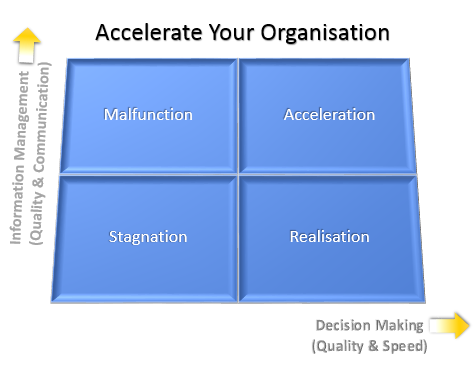This year has started similarly to last with plenty on the airwaves about disruption and the need for innovation and THE strategy before someone else creates a category killer.
The truth is, for every new strategy success story, there is a mountain of non-success stories. Not failures, just failures to come up with THE killer strategy so you become one of those organisations everyone uses as an example of innovation and disruption.
Also, most organisations are not being disrupted as fast and as roughly as the taxi, hotel and bricks and mortar retail industries.
While looking for that killer strategy is always an option, another option, one with faster and more certain returns, is to accelerate your organisation.
I run a lot of workshops. Through all of them there is one common theme. The answers are in people’s heads, they just haven’t found a way to get them out of their heads and into action. The problem is not a lack of innovation or collaboration or productivity or mindfulness or any other management guru’s latest idea. The problem is that you and your staff are not getting ideas out of your heads and into action fast enough. The mechanisms are not in place for accelerated decision making from the top to the extremities of your organisation.
Here’s what happens in a facilitated workshop:
- Information is brought to the workshop in the heads, on the papers and in the devices of the participants.
- Communication occurs and information, that was not otherwise available, is made available across multiple parties.
- Decisions are made and actions agreed.
In the broader organisation on a day-to-day basis, in the same way, information is communicated and decisions are made. The rate-determining step is the length of time to make decisions.
In the diagram below there are four different categories to help you consider what might be holding your organisation back:

- Stagnation is when both your information management and your decision-making processes are poor. There is a very high level of uncertainty. Staff are unsure what information they can trust and it takes too long to find out whether information is good or bad.
- Malfunction is when a poor decision-making process derails your engine. You have good quality information that is comprehensive and arriving in a timely and coherent manner, however, issues such as politics and personal biases get in the way.
- Realisation is what occurs when you have a great decision-making process and poor information management. You find out the poor quality of information for decision making. In this category you can identify what needs to be improved and can usually determine the cost vs value pretty quickly.
- Acceleration comes from good quality information management and decision making where good information is provided in a timely manner and where your decision-making process is swift.
Now here is the knockout blow. Strong, lasting acceleration comes from a feedback loop designed to suit the level of risk or opportunity you face. Successful leaders, in particular entrepreneurs, back themselves that if a decision they make is wrong, they will be able to fix it. However, that is only true if they can identify if a decision is not working out as planned, IN TIME to do something about it.
If you want to know more, please have a watch of my webinar called Decision Making: It’s an uncertain world or grab a copy of my book DECIDE.
